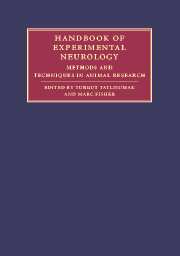Book contents
- Frontmatter
- Contents
- List of contributors
- Part I Principles and general methods
- Part II Experimental models of major neurological diseases
- 18 Focal brain ischemia models in rodents
- 19 Rodent models of global cerebral ischemia
- 20 Rodent models of hemorrhagic stroke
- 21 In vivo models of traumatic brain injury
- 22 Experimental models for the study of CNS tumors
- 23 Experimental models for demyelinating diseases
- 24 Animal models of Parkinson's disease
- 25 Animal models of epilepsy
- 26 Experimental models of hydrocephalus
- 27 Rodent models of experimental bacterial infections in the CNS
- 28 Experimental models of motor neuron disease/amyotrophic lateral sclerosis
- 29 Animal models for sleep disorders
- 30 Experimental models of muscle diseases
- Index
- References
21 - In vivo models of traumatic brain injury
Published online by Cambridge University Press: 04 November 2009
- Frontmatter
- Contents
- List of contributors
- Part I Principles and general methods
- Part II Experimental models of major neurological diseases
- 18 Focal brain ischemia models in rodents
- 19 Rodent models of global cerebral ischemia
- 20 Rodent models of hemorrhagic stroke
- 21 In vivo models of traumatic brain injury
- 22 Experimental models for the study of CNS tumors
- 23 Experimental models for demyelinating diseases
- 24 Animal models of Parkinson's disease
- 25 Animal models of epilepsy
- 26 Experimental models of hydrocephalus
- 27 Rodent models of experimental bacterial infections in the CNS
- 28 Experimental models of motor neuron disease/amyotrophic lateral sclerosis
- 29 Animal models for sleep disorders
- 30 Experimental models of muscle diseases
- Index
- References
Summary
Introduction
Yearly, about 2 million patients will suffer traumatic brain injury (TBI). Much research has been conducted in the field of TBI over the past decades, yet no specific therapy is available. Different experimental models of TBI have been devised over the past years. Since TBI is a heterogeneous condition no single model can depict the actual pathophysiological changes associated with its entire spectrum. Therefore, each model can be seen as representing a subset of injury. Thus, some models are more akin to represent diffuse axonal injury whereas others are more representative of closed head injury with contusions and still others involve traumatic skull fractures with secondary brain impact. Of note, although some in vitro models for TBI exist (for review see reference 8) this chapter will limit itself to discussion of in vivo models. Using each of these models the interested reader may evaluate the physiological, neurochemical, behavioral–cognitive, histological, and pathological sequelae of TBI. Using these methods one can also assess new diagnostic tools and new therapeutic options for neurotrauma. Furthermore, new diagnostic tools such as magnetic resonance imaging (MRI) or MR spectroscopy can be used to further outline TBI pathophysiology.
Closed head injury
TBI is induced in this model by dropping a weight on top of the exposed skull leading to closed head injury (CHI) Adjusting the height and weight of the free-falling weight can modify the severity of the injury.
- Type
- Chapter
- Information
- Handbook of Experimental NeurologyMethods and Techniques in Animal Research, pp. 366 - 374Publisher: Cambridge University PressPrint publication year: 2006



